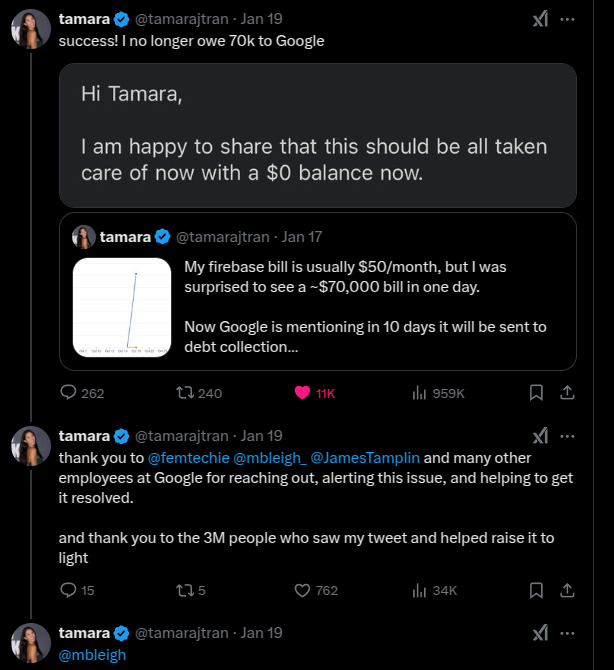
Last Update: January 24, 2025
BY eric
eric
Keywords
The Dark Side of Cloud Computing: Unexpected Costs and Precautions
Introduction
Cloud computing has revolutionized the way businesses and individuals manage data and applications. With benefits like scalability, cost-efficiency, and accessibility, it’s no wonder that cloud services have become a cornerstone of modern technology. However, these advantages come with hidden risks that can lead to significant challenges for users.
This article focuses on one of the most common issues: unexpected costs in cloud computing. By examining real-life cautionary tales, we’ll explore why these costs occur and how you can avoid them.
Cautionary Tales from the Cloud
Story 1: Data Storage Surge and Budget Shock
A most recent story is that a X user posted her cloud service bill on the social network platform.

It was a shocking ~$70,000 bill in one day as she stated.
@tamarajtran has a project relying Google's Firebase service, and her bill was normally $50/month. However, due to a bug in the code, around 1PB of data was unexpectedly stored in the Google Cloud Storage (GCS), which lead to the surging bill.
Fortunately, this story had a happy ending this matter was resolved with the help of the Google staff. @tamarajtran no longer has to worry about the bill.

Story 2: "Wrong" AWS Bucket Name and Unexpected Bill
In April 2024, software engineer Maciej Pocwierz encountered an unexpected $1,300 charge on his AWS account due to nearly 100 million unauthorized S3 PUT requests within a single day. The issue arose because a popular open-source tool used a default (placeholder) S3 bucket name identical to his. Consequently, numerous misconfigured systems attempted to store their backups in his private bucket, leading to the excessive charges. At that time, AWS charged for unauthorized requests, even if they were denied.
According to the report,
The software engineer even demonstrated a simple exploit: anyone knowing a bucket name, even without an AWS account, could try to initiate a connection, which will be denied, but the owner will be charged for each request.
In response to such incidents, AWS announced in May 2024 that it would no longer bill customers for unauthorized requests resulting in specific HTTP error responses, aiming to prevent similar unexpected expenses in the future.
Story 3: Insane Bill
This story was discussed on the Hackers News article. Basically, a user recounted an incident from approximately 2017 where they inadvertently incurred a $15,000 charge on Microsoft Azure. While experimenting with Azure's video processing services, they attempted to disable and detach a service that didn't meet their needs. Despite believing they had successfully shut it down, the process continued running unnoticed, as it didn't appear in the Azure console. The good news was that upon discovering the substantial charge, the user contacted Azure support, who acknowledged the oversight and waived the fee.
Story 4: Unexpected Bill from Years Ago
This is my own story. I used a cloud service about five years ago on a Pay As You Go (PAYG) plan. Essentially, if you don’t pay, you don’t go (no pay, no service). I was charged daily until I stopped using the service, leaving my account at a zero balance as shown in their console.
Years later, I received a bill claiming that I still owed them money for a particular month. This is completely illogical because my account was set up to automatically deduct any charges from my credit card. If there was a gap in the billing, there must be something wrong with their system. And if there was something wrong with their billing system, how could they claim that this is a legitimate bill?
Why Unexpected Costs Happen
- Complex Pricing Models: Cloud providers often use intricate pricing structures that can be difficult to predict.
- Lack of Monitoring: Without tools to track usage, it’s easy to exceed budgeted amounts.
- Unoptimized Resources: Keeping unused or over-provisioned resources running can lead to unnecessary expenses.
- Data Transfer Costs: Moving data between regions or out of the cloud can incur significant fees.
- No Hard Limits: Some cloud providers don’t enforce hard limits, leading to unexpected costs.
How to Avoid Unexpected Costs
- Understand Pricing Models: Familiarize yourself with your cloud provider’s pricing structure, including hidden fees like data transfer costs.
- Set Budget Alerts: Use tools to set spending limits and receive alerts when approaching them.
- Optimize Resources: Regularly audit your cloud usage to identify and shut down unused or over-provisioned resources.
- Monitor Usage: Implement usage monitoring tools to gain real-time insights into your cloud consumption.
- Regularly Audit: Regularly audit your cloud usage and configurations to identify potential issues and take proactive measures.
- Stay Within Free Tiers: If using a free tier, ensure you understand the limits and monitor your usage carefully.
- Better Architecture: Optimize your cloud architecture to minimize over-provisioned resources and reduce data transfer costs.
- Simplify Cloud Usage: Focus on essential cloud services and avoid unnecessary features.
- Use Free Services: Take advantage of free services and credits offered by cloud service providers. Points 1 to 6 highlight precautions that help minimize risks on the cloud service provider's side, while the final three points focus on actions we can take to reduce the risk of unexpected costs on our end.
By designing a better architecture, we can reduce unnecessary cloud usage and make smarter choices when selecting services that suit our business needs. For instance, instead of relying on Google Cloud Storage, we could create an NFS share drive using a virtual machine in the cloud to store our data. This approach allows us to control costs by setting a hard limit on the virtual machine's disk size, mitigating the risk of unlimited storage usage. However, this method increases system complexity, so we must carefully weigh the trade-off between added complexity and reduced cost risks.
Modern cloud providers offer a wide range of features, but using too many of these services—or encountering bugs in our code or third-party code—can lead to unexpected expenses. To mitigate this, it's essential to simplify our cloud usage and focus on core, essential services.
Additionally, some free services can effectively support business operations. For example, Cloudflare provides free DNS name resolution and cloud front services, which can also help mask the true IP addresses of our servers. Leveraging such free options where appropriate can further reduce costs without compromising functionality.
What to do If You Run Into Unexpected Costs
Challenges in Resolving Unexpected Costs
When things like unexpected costs happen, it can be challenging to to contact the provider to resolve the issue:
- Lack of Documentation: Some providers may not provide clear documentation on how to address unexpected costs, leading to delays in resolving the issue.
- Lack of Training: Some providers may not provide training on how to resolve unexpected costs, making it challenging for non-technical employees to address the issue.
- Complex Contact Processes: Many businesses have complex contact processes, making it challenging to identify the right contact person for resolving the issue.
- Unresponsive Support: Some providers may not provide timely support, making it challenging for businesses to resolve issues.
Resolving Unexpected Costs Through Multiple Communication Channels
When evaluating a cloud service provider, it’s crucial to consider their reputation for customer support, as reaching their support team can sometimes be challenging. Reliable and responsive customer service can make a significant difference in resolving issues effectively.
To maximize your chances of getting assistance, try contacting the provider through multiple channels, including their support, sales, and customer service teams. Use every method available—email, phone, and social media. However, keep in mind that phone support is often reserved for premium customers with many cloud providers.
If you’ve exhausted all official communication channels, consider sharing your story on social media. Social platforms can amplify your message, potentially connecting you with the support team and allowing you to highlight your experience. This approach can also provide valuable insights into the provider’s operations and how best to address your concerns.
Conclusion
Cloud computing offers immense potential, but unexpected costs can quickly overshadow its benefits. By understanding how these costs arise and taking proactive measures, you can ensure that your cloud investments remain cost-effective and sustainable.
While the cloud provides flexibility and scalability, vigilance and preparation are essential to avoid budget shocks. Take the time to review your current strategies and implement safeguards to keep your cloud usage under control.
Please note this article does not aim to diminish the benefits of cloud services. Instead, it seeks to highlight potential risks and provide guidance on managing them effectively.
Contact
If you have any questions or need further assistance in regarding finding a cloud service suitable for your business or optimizing your cloud usage, feel free to reach out to me on:
- X (formally twitter): Eric Tang
- email: [email protected]
References
Previous Article

Jan 25, 2025







Comments (0)
Leave a Comment